We can’t return we can only look behind
from where we came
and go round and round and round
in the circle game…
—Joni Mitchell from The Circle Game
I’ve had a strong identity with the American persimmon tree since childhood. As a boy, I was particularly fond of the fruit because my grandmother and other relatives used it to make a most delicious pudding. The wild persimmon is native to areas of southern Indiana where my family originally settled, and the persimmon pudding I ate as a boy was made from recipes that had been passed down through generations.
Yet the American persimmon has also influenced me in another way. Its wood became known to me through the game of golf, which I began playing when I was twelve years old. My ambition then, like most boys in Indiana, was to become a star basketball player. That plan went fine until I reached seventh grade. I was one of the better players in my neighborhood so I tried out for the 7th grade basketball team at my junior high school in Terre Haute, Indiana. Although I made the team, I played only a few minutes in actual games. After that year, almost everyone else on the team grew taller. I did not. I was still only five feet-five inches in height as I entered eighth grade. It was clear to me, and probably my coach, that basketball was not to be my sport.
About that same time, my Dad decided that I should take up another sport—golf. He had played golf since his days in the Navy during World War II, and he convinced me that golf was a more practical option for me since I could play it throughout my life. During that same winter of 1959 when my basketball career was waning, he arranged for me to take golf lessons from a pro he had met at one of the bars in town. He also bought me a “starter” set of golf clubs bearing the name of a professional golfer of that time, a woman named Betty Alex. After all, I was short in stature.
*******
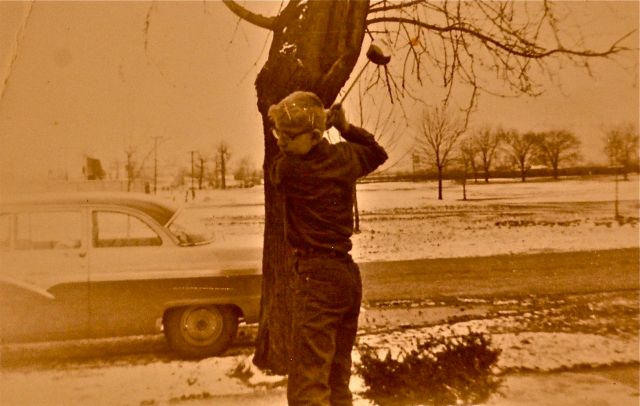
Swinging “Betty Alex” golf club during winter 1959. The Stadium Golf Course is shown across the street.
Each week during the winter of 1959, I rode the city bus into downtown Terre Haute after school and on weekends. I entered a dilapidated building along Wabash Avenue, the main street of town at that time, and climbed a long, steep wooden stairway. I then entered a large room where the pro had his golf school. He had suspended two large canvases from the ceiling at opposite ends of the room; each was about 20 feet from a mat fitted with a tee. As a golfer received instruction, he stood on one of the mats, teed up a ball and hit it into the nearby canvas while the pro or his assistant looked on. The ball would strike the canvas with a loud thud and then drop to the floor and roll back towards the golfer. Another ball was then teed up and hit.
The pro was always there when I went to the school. He wore a dress shirt and tie and smelled of strong men’s cologne. His attractive female assistant was usually dressed in a sweater and slacks. There were usually two persons taking lessons at the same time, one at each end of the room, so the pro would work with one patron and his assistant coached the other. Both the pro and his assistant knew golf, and over my two-months at that school I learned to hold my clubs and swing them correctly. I didn’t receive much instruction about putting or chipping, but my time in that school helped establish for me a sound, consistent golf swing, which was a distinct advantage as I continued to pursue the game.
After participating in golf school, I felt ready to take on a real golf course—and I didn’t have to go far to do it. My family’s house was located directly across the street from the second tee on one of Terre Haute’s municipal golf courses. It was a nine-hole layout where the holes were mostly shorter in length and had pars of 3 or 4; there were no par-5’s. It was built on a level piece of ground around the municipal stadium, and although it wasn’t in very good playing condition most of the time, a youth pass cost me less than ten dollars for the entire season. With that pass, I could play as much golf as I wanted. I went almost every day during the spring, summer and fall. The course was simple, but it certainly challenged me at that point in my golfing journey and I learned to hit every club in my starter set (the putter, 9-iron, 7-iron, 5-iron, 3-iron, driver and 3-wood. These latter two clubs were made with genuine American persimmon—of course–since that was the most-popular wood for golf club construction during the first half of the 1900s. I used this starter-set of clubs and my persimmon woods until I was a senior in high school. More significantly, I played competitively with them for two seasons as a member of the Gerstmeyer High School golf team. And then I grew.
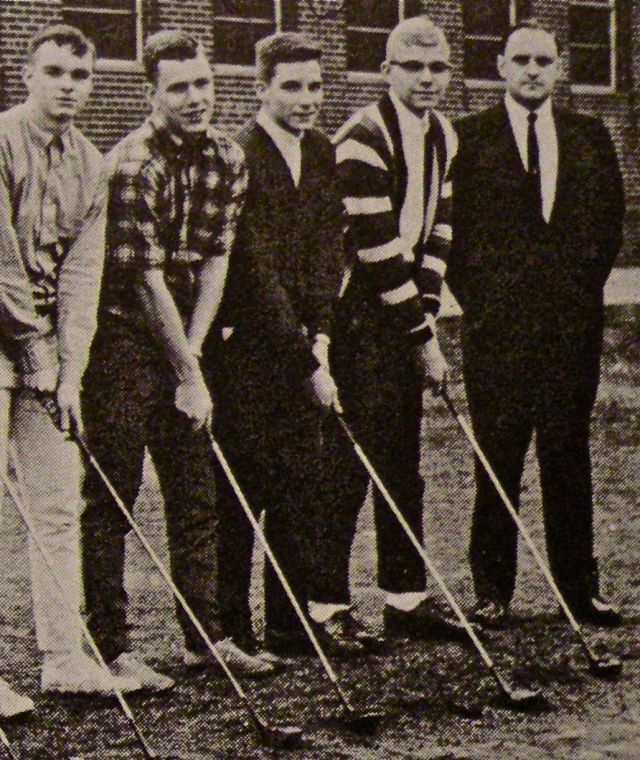
Members of the 1964 Gerstmeyer High School golf team (L to R: Robert McCauley, Ken McNiel, Donald Anthony, Steve Simmons, Coach Donald Pritchett)
By midway through my senior year of high school, I had grown to six feet – one inch in height. My Dad then got me another set of golf clubs to use during my final year of competition for the school team. We picked out a set of Wilson Sam Snead Championship clubs—and this time they were a full set with men’s-length shafts. They boosted my golfing self-esteem and confidence, and I had my best year of competition of all. For two months during the spring of 1964, I was on top of the world.
What I didn’t appreciate at the time was that my new Sam Snead Championship clubs also marked another milestone. They represented the departure of persimmon wood from my golf bag for almost fifty years. However, golf is a “circle game” and persimmon wood recently returned to my game. This is the story of my reconnection with persimmon in golf and its significance for me.
********
In 1963, the Wilson golf club company began using a new approach for constructing golf clubs. They called it “Strata-Bloc” and one advertisement in that time noted:
Fifty years ago, golf was a gentle game with clubs to match…[but] the game was changed to power-for-distance by the invention of the…powerful Wilson Strata-Bloc wood head. This unique wood construction has given millions of golfers a new feeling of confidence and power…
I, of course, needed all the confidence and power I could get in my golf game then, so I accepted the company’s position without hesitation. My new Sam Snead Championship clubs were made using the Strata-Bloc technique, which meant using some softer wood than persimmon and then laminating it before forming it into a club. Each Strata-Bloc club head was manufactured using exacting specifications and was identical to all others; uniformity was the company’s goal. About that same time, another manufacturer began constructing clubs from “tomorrow’s material,” which wasn’t wood at all. Their advertisements claimed these clubs would not “shrink, swell, warp or wear [like wood does].” But they were careful to note (for the sake of the golfing purists) that these new clubs possessed “the same playability and feel of fine persimmon.”
By the 1980s, most club manufacturers had moved entirely away from persimmon wood for making golf clubs. “Metal-woods,” which were constructed from titanium and other metal composites, became the rage. I received a set of such clubs as a gift from my brother Phil during the 1990s. They were made by Wilson and carried the name “Aggressors.” The clubs were fine, but their name just didn’t seem to fit my game–or me–very well.
For most of the 1990s and the first decade of the 2000s, I seldom played golf. Then two years ago I made a decision to begin playing more frequently again. I initially thought I might go back to playing with my Wilson Sam Snead Championship clubs again, however a couple of sessions with those at a driving range convinced me otherwise. I just couldn’t hit them consistently anymore. I chose instead to buy a new-concept Callaway driver and 3-wood, which although they share the same black color as my original persimmon-headed “Betty Alex” woods, are as different from those earlier clubs as anything I can imagine. My new clubs are made of “forged composite” construction, which according to the company is lighter and stronger than titanium. In fact, the material in these clubs is supposed to be the lightest, strongest material ever used in golf club construction. If I needed any further persuasion as to why these clubs should be right ones for me, the company literature concluded:
Now everyone wants to have the advantage of owning a Diablo Octane driver. If you want to stand out on the golf course, it’s the ultimate weapon.
These new clubs were certainly easier to hit than my 1950s and 1960s-era Betty Alex and Sam Snead Championship clubs. Their increased club head size alone, compared to the older ones, could account for that. However, I still struggled with the idea that my new golf clubs should somehow be regarded as weapons? That idea represented an entirely different mindset in the game compared with when I first began playing. Changes in club names from “Betty Alex Pro Model” or “Sam Snead Championship” then to the likes of “Aggressor,” “Diablo Octane,” and “Cobra” in recent times says it all. I still think of that Wilson club advertisement from fifty years ago that described golf as “a gentle game with clubs to match.” Not anymore.
*******
Speaking of weapons, I doubt that many players can say they play golf with a Samurai. I do. That is the result of a gift I received from a friend, Bob Guiney. He lives in the same town as my mother, and whenever I visit her I usually arrange to play golf with Bob. During a recent outing together, Bob gave me this Samurai golf club (which I had earlier admired). I wasn’t too sure about the implications of its name, but it seemed harmless enough and I did admire its sleek black color and its smooth lines. After we had finished playing our round, Bob said, “I think you should take that club, Steve. You’ll make better use of it than I will.”
The Samurai dates to the early-1990s when it was a forerunner of the modern “hybrid” clubs. Hybrids combine the qualities of both long irons and fairway woods. When I learned to play golf in the 1950s and ’60s, everyone played with long irons (#1, #2 or #3 iron). I never used a #1 iron because it was too difficult for me to hit well, and the #2 or #3 irons were my least favorite clubs in the bag. Their low loft and small striking face made the “sweet spot” seem to be nonexistent. There was even a joke about such clubs then that went:
Do you know the best thing to do when you’re caught in a thunderstorm on a golf course? Simply stand in the open and hold a long iron above your head. Even lightning can’t hit a long iron!
My Samurai, and the hybrid clubs that came later, were meant to replace long irons for most golfers–and they have. I don’t even carry a long iron in my bag anymore.
But my Samurai has even more significance for me than its name and sleek lines. It represents the first step I took towards bringing persimmon back into my golf game again. Let me explain. The principal material in my Samurai club is graphite, and there is even a label on the club to that effect. Graphite is mostly carbon (actually a high grade of coal), and in my Samurai club it is mostly used to add light-weight strength and flexibility. The graphite found even more importance for me when I learned that its carbon originated in plants growing during the Carboniferous Period more than 300 million years ago! The structural orientation of graphite also resembles that of cellulose, a principal component of persimmon wood. Although my Samurai club isn’t made with persimmon, its graphite is related at a molecular level–both contain carbon atoms arranged in layers. Graphite is more like persimmon than titanium or other metals commonly used for making modern golf clubs! I know it’s a stretch, but one has to begin somewhere.
I was fortunate to come to golf at a time when I could still hear the echo of persimmon wood in the game. Most people know that golf originated in Scotland and has been played there since at least the 1400s. Early clubs were built by master craftsmen like Peter McEwan, one of the best club makers in Scotland during the 1870s. McEwan and other makers of that time created a club called “long nose.” When I look at my Samurai from above, I’m reminded of this early club design. Before golf courses were groomed as they are now, players often had to hit from long grass and thick vegetation. My hunch is that this “long nose” design helped golfers hit better shots under such conditions. I also expect that this design was duly noted by those who first created my Samurai or the hybrid clubs that came later.
*******
Even during my college years in the mid-1960s, I began to realize I’d lost something when I stopped using my persimmon golf clubs in high school. I was living in New York State then and I decided to place an ad in a local newspaper to see if I could buy some antique golf clubs made from persimmon and hickory. A man responded and sold me a set of clubs dating to the early 1900s; I’ve had them ever since. The woods are so old that they don’t even have inserts in their faces to protect them from wear. With these 100 year-old woods it’s just persimmon on ball, and they do represent “a gentler time” in the game of golf and in the world itself.
A couple of years ago, I finally got around to actually hitting a golf ball with my vintage persimmon clubs. I took one of the oldest, a 100 year-old fairway wood, to a practice range near my home. Everything about this particular club was old—its leather grip, its hickory shaft and its persimmon head. I didn’t know when this club had last been used, but I knew that when I hit it, I would experience the sound and feel of a golf shot unlike anything I had ever experienced before. I addressed the ball and began my backswing; it seemed like any other. Then came the moment of impact with the ball. I can best describe that sensation as “solid.” The sound was different too, not at all like the “pingy” resonance one hears when striking a ball with a modern metal wood. Most memorable for me–the ball flew like the wind!
*******
Of the newly-assembled clubs in my golf bag, the putter is most interesting. Putters have always been ripe for design gimmicks and promotions meant to convince us golfers of their superiority. With my 1964 clubs in high school, I chose a putter made by the Wilson company named the “Greenbrier,” which was the home golf course in West Virginia of my favorite golfer at the time, Sam Snead. This putter had a copper insert in its face, which I appreciated then mostly for its appearance. I’ve since learned, however, that copper was regarded at that time as a material that purportedly gave golfers “a true feel” around the greens. I can’t honestly say that my Greenbrier putter was much better than the copper-free putter that came with my original “Betty Alex” starter set, but maybe I’m just a skeptic at heart.
Skeptic or not, I read a lot about golf and golfing equipment then. I perused every golf advertisement looking for equipment that could improve my game. One ad, for instance, offered a marble putter, which was described as “sensational.” It was intended to give a golfer “greater accuracy.” I didn’t believe it then, and I still don’t–oh me of little faith.
There was also an ad at that time for a putter that had a “solid persimmon back.” I liked the idea of incorporating persimmon into a putter’s design, but this one had a significant flaw–the persimmon never actually touched the ball! I didn’t buy that one either.
*******
Since returning to playing golf regularly, I’ve kept Bob Guiney’s gift Samurai club in my bag, partly to remind me of my quest to bring persimmon back into my game. I’ve added a replica 1922 “mashie” for use in pitch and run situations around the greens. I’ve also taken one of those 100 year-old vintage clubs I bought fifty years ago out of retirement and use it for chipping situations near the putting surfaces. These latter two clubs each have hickory shafts, so wood had come back into my game–but it wasn’t persimmon. Then I found my True Center.
While doing research for this essay, I came upon a contemporary golf advertisement for yet another new putter. This one is made by the Louisville Golf Club Company and is similar in design to other blade-style putters with one exception–it has a small piece of genuine persimmon wood inserted directly into the putter blade’s face where it can make direct contact with the ball whenever the club is stroked. This persimmon is functional, not just decorative.
Persimmon wood has been described as “nature’s gift to the game of golf.” It has a higher density than oak or hickory, and one club manufacturer remarked, “Persimmon is not too soft, nor too hard — it’s just the ideal material.” He added, “No man-made material can duplicate the vibration-dampening characteristic of persimmon wood.” I wasn’t quite sure how “vibration-dampening” might improve my putting, but I was drawn to this putter because of its prospect for bringing persimmon back into my game. One more testimonial accompanying the ad for this club stated: “The moment of inertia of this putter is super high and makes it very forgiving.”
Vibration dampening and forgiving plus genuine persimmon; I concluded that this was the putter! And there’s one more thing about it, the name—“True Center.” That sealed the deal for me.
*******
…the end of all our exploring will be to arrive where we started and know the place for the first time. –T. S. Eliot
Since acquiring my True Center putter, I’ve continued exploring why it is so important for me to have brought persimmon back into my game. In Joni Mitchell’s song, The Circle Game, she asserts that one can’t return to the past, which is certainly true in a temporal sense. But Joni also points to cyclical and circular aspects of life, and I believe that applies to golf as well. When I begin a new round of golf by standing on the first tee, I know that as I persevere through the sequence of nine or eighteen holes ahead of me, I will arrive where it all started. And when I return, I won’t be the same person as when I began. I will be a bit wiser (at least in a golfing sense) and will have experienced moments of ecstasy as well as of doubts and discouragement. When I play golf in the company of others, we can share conversations and build relationships during a round that are quite profound. I play occasionally now with three men who have golfed together since childhood–a period of more than sixty years. Their shared experiences over the many courses and decades have created for them a bond that can only be described as sacred.
This is all well for describing golf’s symbolic importance in one’s life, but what about the significance for me of having returned persimmon to my game after an absence of fifty years? It’s only wood afterall, and a small piece at that, yet I think this persimmon wood points to a deeper significance. When I first learned to play golf during my teen years in Indiana, I sometimes heard an expression from more experienced golfers: You drive for show and putt for dough. I’ve not forgotten that and have experienced its truth in my life with golf; excellent putting is central to one’s success. It’s significant to me that this small piece of persimmon wood has re-entered my golf game at its very epicenter–in the face of my putter–and here’s what I mean by that:
I carry fourteen clubs in my golf bag; along with the bag and associated accessories, it weighs about twenty-three pounds. The putter accounts for just one pound of that, yet my effectiveness in all future rounds of golf hinges on that putter. The persimmon wood inserted into my putter’s face weighs less than an ounce, yet it’s fair to say that my future putting prowess depends entirely on the quality of the contact between that wood and my ball. In a real sense, this persimmon is at the true center of my golf game, and it helps me to keep a most important question centered in my mind for golf (and all of life): What really matters?
The persimmon wood in my putter also symbolizes another reality. It reminds me of those early Betty Alex golf clubs with which I first learned to play the game and through which persimmon wood initially came to me. Yet my memories of those clubs also resurrect other less-pleasant aspects of my life during that earlier time–unfulfilled aspirations, low self-esteem, feelings of inadequacy—plus a perception that I wasn’t quite living up to the expectations and ambitions of my father for me. This latter perception persisted until after my Dad died in 1986. Since coming back to golf, I’m appreciating the game–and my place in it–in a new way. I’m understanding what a profound gift my Dad gave to me in 1959 when he persuaded and enabled me to take up this special game. I don’t know all that motivated him to do so, but I’m now able to realize that part of it was his love for me–and that discernment is now my true center.
__________________________
Steve Robert Simmons wrote this personal essay in 2013. All rights reserved.



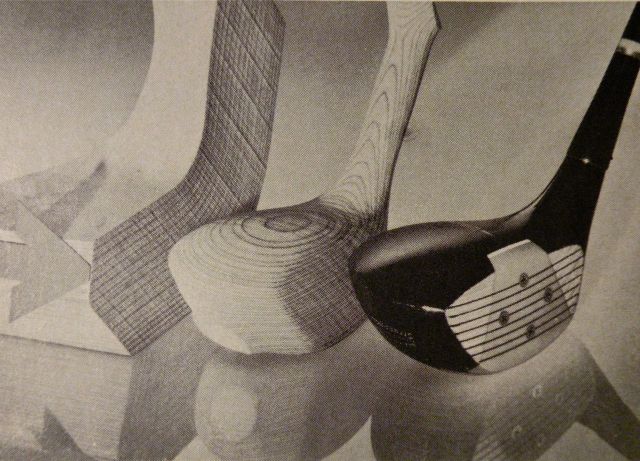

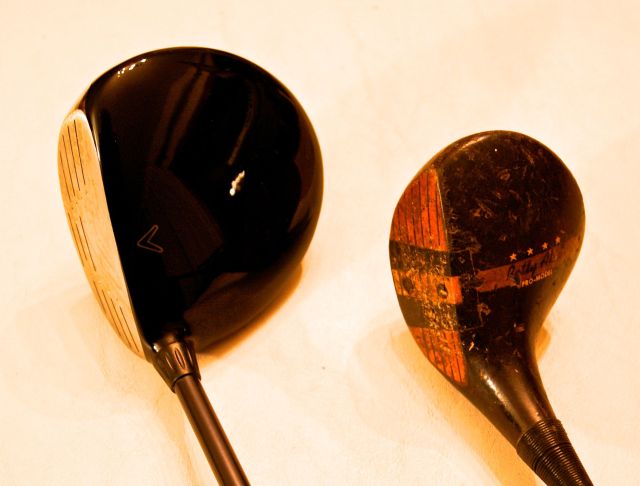

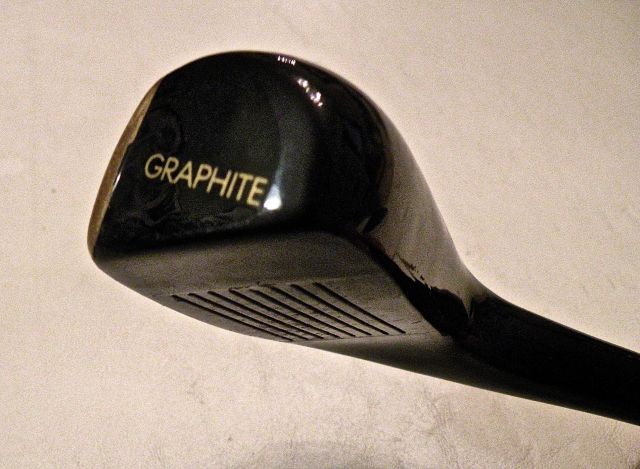







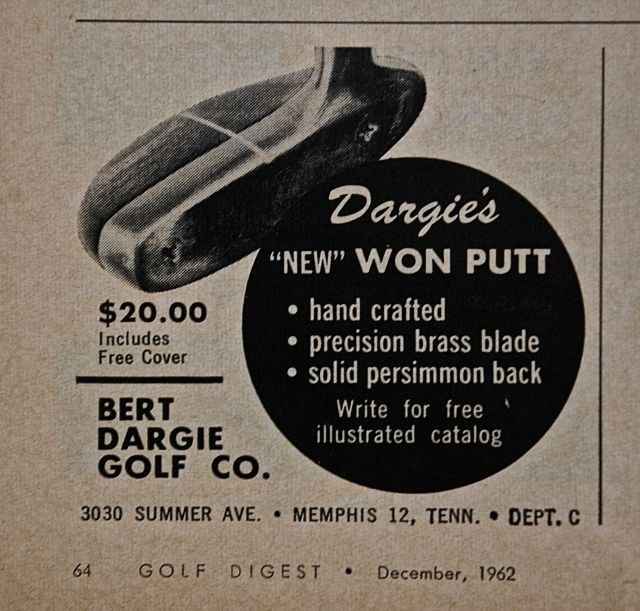

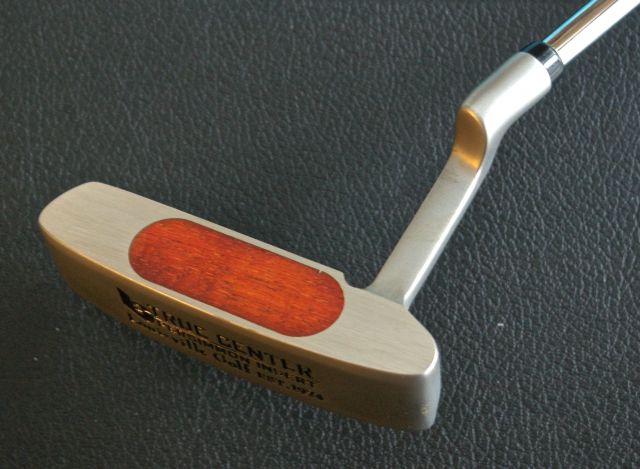

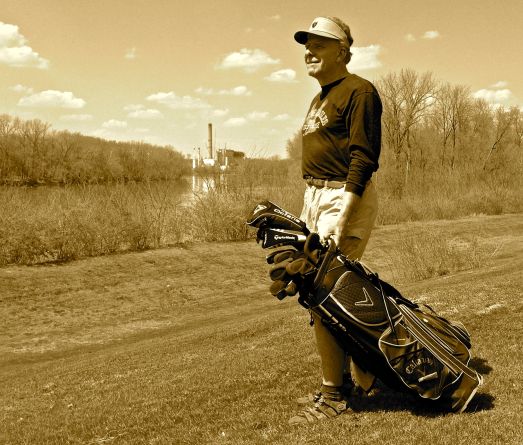
Great story. Bob Guiney is a friend of mine and he told me that their is not a club in his bag that would help me. Terry Boylan, Camp Hill Pa
Good to meet you, Terry. Glad to know we share a friendship with Bob–what a GREAT guy! Bob and I played golf together when I was visiting in his area last week, and I got to use my Samurai club with him present. It performed like a charm; those 300 million year-old graphite carbon atoms really did their thing. 🙂
Well, you did it. I’m not a golfer, but you kept me interested… riveted, in fact. And you brought the story around to “what really matters”; that your dad loved you, despite your inadequacies and low self esteem.
Thanks, Melanie. It means A LOT to me that this essay spoke to you as a non-golfer. You’ve made my day! 🙂
Well, Steve, I really enjoyed your essay. Like you, I have also had a series of golf club sets. I started a couple years later than you, so I missed the “persimmon” era. I got my first set in the mid-60s – also a set by Wilson with the stratobloc construction – Wilson K-28s. I kept them until until the mid-80s, but I used them infrequently as I did not have much time for golf with my family and career priorities. But in the 80s I picked up the game again, and I figured that initial set was “old” and I could do better with “better” equipment, so I bought a new set of clubs. This happened again about 5 years ago when I bought some new “improved” clubs. Funny thing though – the miracle clubs really did not improve my game all that much. Nevertheless, I still enjoy just going out and playing — occasionally hitting that wonderful shot that we all dream of. Through it all though, I think the main thing I have learned from my many seasons of playing golf is to just enjoy the game and not get too frustrated with my lack of ability with these new “superclubs.”
Thanks for your thoughtful response to my new essay, Dale. It’s neat to hear a bit about your own journey with golf clubs through the years.
I hope to be out your way later this summer so maybe we can get in a round of golf together. I would like that very much. And if you’re really nice to me, I’ll even let you take some strokes with my True Center putter. 🙂
Steve, I started playing golf (and for me it is always playing golf and not golfing) when I was a preteen. I still use my father’s putter which has a wooded shaft and is older that I am, and I never had a metal “wood” because that “ping” was foreign to me. I still have the same clubs that I used years ago and could play a round in the 70s or 80s and therefore I have concluded that my current inability to play anywhere close to that has nothing to do with the clubs!
So many great memories were recalled while reading your excellent essay. Thank you!
I would like to see your putter sometime, Dick. Perhaps we could compare our hickory-shafted clubs! And if you regularly shot in the 70s back in the day, you were definitely above my grade. I only shot in the 70s once, and that was a fluke–or Divine intervention–one or the other. 🙂
What a wonderful reflection, Steve. I have realized that the club won’t produce the same result if the swing isn’t replicated. This year I have decided to change my swing back to the one I used as a teen. I haven’t yet gone back to any clubs from that era but I have hopes that I may be able to replicate some of the results, however, I will continue to enjoy the game only if my expectations are realistic. I can’t wait to see some of your “new” clubs. You were able to “output” me with any putter; this new one may be dangerous. Let’s play soon.
Thanks for taking time to read and respond to my new golf essay, Mike. As you know from the essay, I too toyed with the idea of going back to the clubs of my youth thinking it might also bring back the strengths of my game then. Sadly, that was not to be. I am much more pleased with the results I get with my newer clubs–with the exception of the hickory shaft mashie and putter that I use for chipping and the True Center putter. I do look forward to showing those to you when we get together for our next round of golf together.
Another fun read for me, Steve, on one of my favorite topics. While my real start in golf came much too late for the persimmon era, I love the history and traditions of golf and can never get too much of it. We do have an interesting connection in our introduction to golf. My “real” start began in 1998 in an indoor teaching facility in Interbay, just across the street from the new driving range. As the student, I hit off the mat into a netting that also tended to “deliver” a well-struck ball back to the mat area. Unlike your learning center, however, this facility had video equipment that showed you every viewing position of your swing. Likewise, even my initial clubs were of a much later vintage than the persimmon variety and as a lover of the technology, I am already on my third complete upgrade since that initial set. However, I am intrigued by the possibility of borrowing your new persimmon putter to experience that dampening and forgiving strike that will send my ball straight into the hole – do you think that could be arranged on one hole, just one??? Thanks again for a great read and I sure hope to catch at least one round with you here in the Seattle area later this summer.
Thanks for reading my new golf essay, Walt. It certainly can be arranged for you to try out my new putter. I used it today in a round and it was SWEET!! Its “dampening” and “forgiving” properties ARE the only way to go!! 🙂 Incidentally, for a guy who came to golf later, you sure play a GREAT game! Keep it up.
I found your Samurai references interesting. I have a complete set that I am trying to sell locally, however people are not familiar with them and tend to be leery of them. Their rarity makes them a little more valuable than the normal used club, but it also makes people afraid to use something so unique and unusual. Everyone loves the hybrid but not too many want a bag full of them. It’s a shame because I know there is someone out there searching for a set of Samurai.
I thought I had already replied to this. I agree that the Samurai is a most interesting club, and as I said in the essay, its design may be quite old. When I hit the Samurai well, it is sweet indeed, but when I miss hit that club it feels like a rock–not at all like a misfired hybrid. So that probably explains why the Samurai has fallen out of favor as a club for play. Now, alas, it may be relegated to the status of “curiosity.” ;-(
Steve,
I really enjoyed your essay. I played golf at Gerstmeyer a couple of years ahead of you. Bobby McCauley is a good friend of mine. I made a hole in one on 2 at the Stadium Course. Do you remember Ed Light? My Uncle gave me a bag of old wooden clubs; and me and my brother used them to start playing at the Stadium. I quickly went to steel shafted clubs. Shamefully I carried one wooden club so that I could shatter it on a tree when I hit a bad shot. I hope I have matured past that.
Hit ’em straight.
Jim Andrews, Gerstmeyer 1961
Thanks for responding to the “My True Center” essay. It’s great to hear from another Black Cat golf team member. 🙂 Please give my regards to Bob M. (the original “Lefty” long before Phil & Bubba). Never had a hole in one, although I did score an eagle on the 3rd hole at the Stadium once when I holed out my second shot. I do remember Ed Light, but only faintly. Do you remember the punch board in the starter’s shack? For a dime you could punch out a strip of paper from the board, unroll it, and see if you won a new Titleist golf ball. What wood-shafted club did you carry–and break? I remember one guy who still played the Stadium course with hickory clubs into the late 1950s. The only club I remember of his was the “jigger.” I liked that name. 🙂
It is fun to read your writings and to communicate with a fellow Huatian(Is this how they spell it? This is a relatively new term to me.) My uncle gave me a bag of about twenty wooden shafted clubs. They had those exotic names like mashie and niblick. I actually shattered several because I didn’t really know the value of them. You must have played with Bill (Bud) McCauley, on the 1962 Blackcat team. We had a big rivalry with Wiley H.S.; could you guys beat them? It is a shame the Stadium Course is gone. I worked at Rea Park after I got out of the Air Force, and was going to ISU. In the Air Force, I did 30 days TDY at the French River MN Missile Site. I was in teletype, but the launch officer and I were the only ones in the Command Center at night. I guess I was supposed to kill him if he went crazy and decided to launch(Dr. Strangelove?.).
I don’t remember Bill McCauley, but I was a lowly soph and he may not have associated with me. I do remember Gary Staley on that team who was also a basketball star. I only played golf, but a rising tide carries all ships. 🙂 I remember well our matches with Wiley. Had the chance this past summer to reconnect with John Blickenstaff who played for Wiley then and was one of my opponents in dual meets. He’s a great guy despite his Red Streak pedigree. 🙂
Interesting to know of your connection with missiles at French River near Duluth. I was an ICBM missile launch officer in Wyoming for 4 years so have some sense of your Dr. Strangelove existence. 😉
Forgot to respond to your query about the punch board. Yes, I remember it well. A kid that hung around out there and I had a deal with Ed Light; Ed gave us 75cents for a winning punch, instead of the ball. We had plenty of golf balls from hunting across the road beside hole 3 and over the Stadium fence by hole 8. You wrote in one of your essays about the deep centerfield fence at the Stadium; I stood at homeplate and hit irons over it. Luckily the groundskeepers didn’t see me.
You were quite the entrepreneur back then. 🙂 I also looked for balls in the weeds along Locust Street. Remember finding a mesh-patterned ball, which I sure wish I still had today with my interest in hickory-era golf.
I know John Blickenstaff very well. He coached the Martinsville HS team and I coached the Brownsburg HS team. The schools had a good rivalry in golf. John still hits the golf ball a very long way, and plays well. Like you said, good guy.
Glad to know that you and John coached against each other, Jim. When I played against him in high school, I don’t remember him being a particularly long hitter. But he, like all of us then, was still playing persimmon woods. I still play with them–and hickory shafts to boot–so a 220 yard drive is a good day for me. 🙂